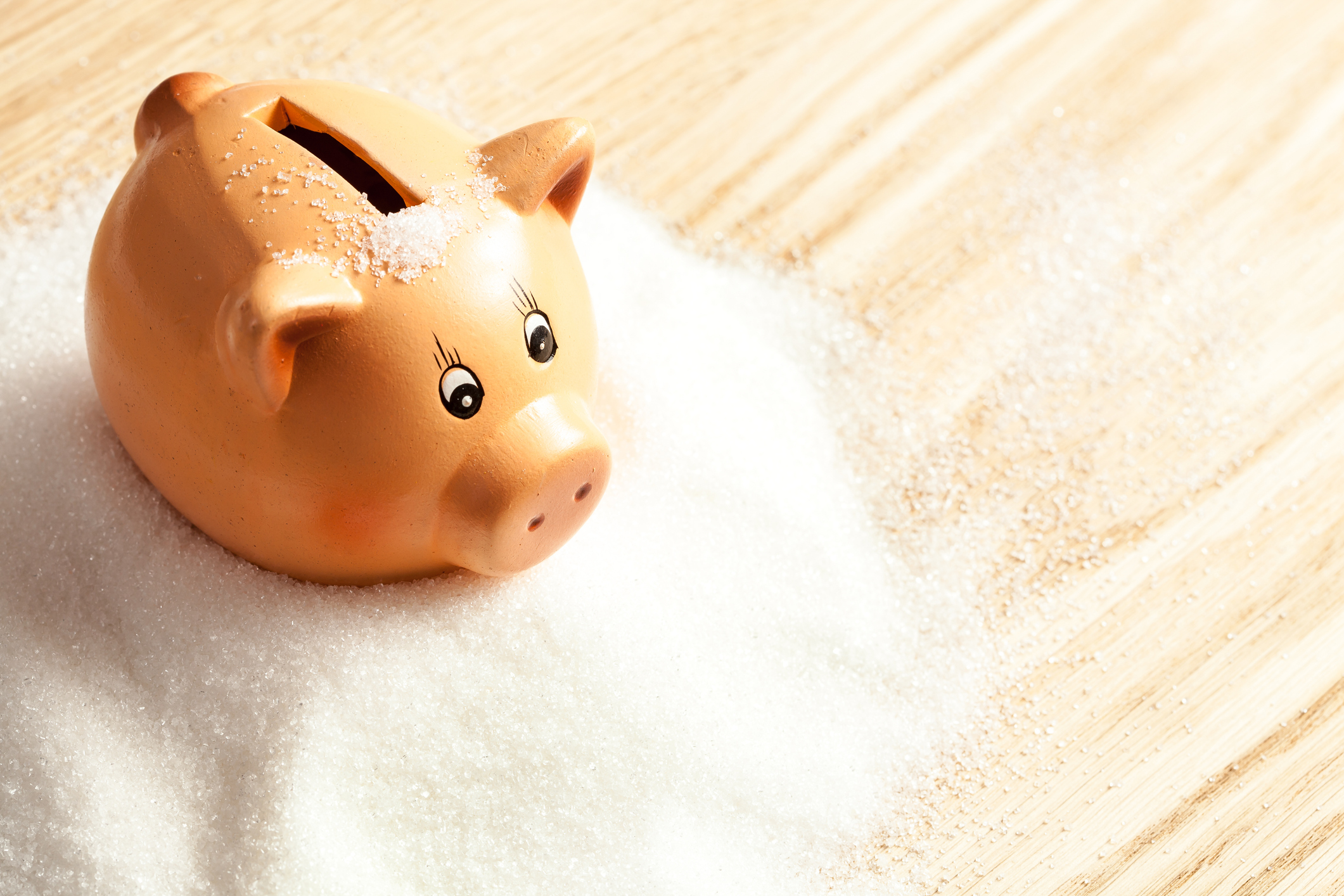Could a sugar rush protect you from a stock market crash?
Sugar has some defensive qualities during economic downturns, but is now the right time to invest in sugar?


As Easter approaches, sugary products are going to be high on everyone’s supermarket shopping list. But should a sugar investment or two also make the cut?
Adding a sweetener to your portfolio could diversify it away from the highs and crashes of the stock market. Sugar, in particular, historically has a low level of correlation with equity and bond markets. That’s because the major drivers of sugar prices are supply-side and primarily dependent on weather patterns in the main producers of sugar: Brazil, India and Thailand.
“Supply shocks tend to drive those rapid price surges that we see in sugar,” says Aneeka Gupta, director, macroeconomic research at WisdomTree. “When we look at the broader macro narrative that’s unfolding in the markets, sugar tends to serve as a commodity that offers much lower correlation to these broader assets that an investor would be holding, and hence offers that diversification benefit.”
MoneyWeek
Subscribe to MoneyWeek today and get your first six magazine issues absolutely FREE

Sign up to Money Morning
Don't miss the latest investment and personal finances news, market analysis, plus money-saving tips with our free twice-daily newsletter
Don't miss the latest investment and personal finances news, market analysis, plus money-saving tips with our free twice-daily newsletter
While that gives sugar a defensive quality, make no mistake: this is a complex commodity, and now is an uncertain time to invest in sugar.
We’ll take you through the investment case for sugar, explaining the main drivers of sugar prices, as well as how the current market dynamics could impact sugar prices going forward and the ways to gain exposure to sugar if you find yourself developing an investing sweet tooth.
What drives sugar prices?
There are three main influences on the price of sugar.
1. Sugar as a foodstuff
Global demand for sugar as a foodstuff is relatively stable. Sugar is a staple ingredient across the world, and as such, demand doesn’t fall much even during economic downturns.
There’s even an argument that recessions increase sugar consumption. When times are tough, households typically shift towards cheaper foodstuffs, which tend to have a higher sugar content. Research from the Institute for Fiscal Studies, for example, found that British households increased their sugar consumption by 0.27g per 100g of food during the course of the Great Recession (2008-2012). That, historically, has given sugar defensive qualities: it can offer protection to portfolios when the rest of the market falls. However, in recent years, this has been complicated by the increasing demand for ethanol to make biofuels.
2. Sugar as a biofuel
Sugar cane is a perfect resource for this, particularly in the countries that produce most of the world’s sugar. That gives sugar prices a degree of correlation with global energy prices: if oil prices rise, that increases the incentive to use biofuel instead, meaning cane farmers are more likely to sell their produce for biofuel than to the food industry – increasing total demand for sugar. In other words, higher energy prices mean higher sugar prices.
Since energy demand is closely correlated with the global economy, this constitutes an increasingly cyclical influence on sugar prices, the opposite of its traditional defensive attribute.
3. Sugar supply
The third influence on sugar prices is supply-side, and forms the core of the investment case for sugar. The biggest driver of sugar supply is the climate, particularly in Brazil, India and Thailand.
“Sugar production tends to be highly vulnerable to weather events like droughts and monsoons – the El Niño and La Niña weather cycles,” explains Gupta. In general, drier La Niña conditions reduce sugar harvests, pushing up prices.

Climate influences on sugar cane crops are the biggest single driver of changes in sugar prices.
To a large extent, the weather-driven supply dynamic forms the core of sugar’s investment case. While stock and bond markets rise and fall on macroeconomic policy, sugar’s biggest price influence is completely unrelated.
This is a big source of risk, but it’s also the main reason why sugar is worth considering as an investment – particularly when the macroeconomic picture is turbulent.
How will tariffs impact sugar prices?
On the whole, tariffs aren’t great news for sugar. Though it produces some of its own sugar, the US is the world’s largest consumer and a net importer of the stuff. So, a baseline 10% tariff on all imports could be bad news for sugar prices globally.
Add to that the fact that a global slowdown could reduce energy consumption and therefore lower energy prices, and the picture looks gloomy in terms of sugar demand.
However, the full picture is complex and hard to predict. Should the tariffs cause a global recession, then sugar’s more defensive characteristics could come into play.
“The way we’re looking at it is that this uncertainty surrounding current policy is going to increase the price volatility and stimulate a more speculative environment within the sugar market,” says Gupta.
It also bears repeating that the biggest influence on sugar price is the climate. There is upside and downside risk in sugar, but its biggest drivers are separate from those driving stocks and bonds.
How to invest in sugar
If you are thinking of sprinkling a little sugar into your portfolio for diversification, there are several approaches possible.
- One way to invest in sugar is to buy shares in sugar companies.
Two of the UK’s largest are British Sugar – a subsidiary of Associated British Foods (LON:ABF) – and Tate & Lyle (LON:TATE). Buying commodity stocks like this, though, introduces a level of corporate risk, effectively bringing the macro picture more into the frame. - Alternatively, for pure play exposure to sugar prices, an exchange-traded commodity (ETC) – effectively an ETF that tracks the price of a single commodity – might be a better approach.
One option here is WisdomTree Sugar (LON:SUGA). This effectively tracks sugar futures, although Gupta cautions that its returns are impacted by the rolling of those contracts when they reach expiry, meaning its total returns are based both on spot price movements and the roll yield, not just price changes. - Sugar may also be included as part of a broader commodity index – for example, the S&P GSCI Softs Index, which tracks coffee, sugar, cocoa and cotton prices.
Get the latest financial news, insights and expert analysis from our award-winning MoneyWeek team, to help you understand what really matters when it comes to your finances.

Dan is a financial journalist who, prior to joining MoneyWeek, spent five years writing for OPTO, an investment magazine focused on growth and technology stocks, ETFs and thematic investing.
Before becoming a writer, Dan spent six years working in talent acquisition in the tech sector, including for credit scoring start-up ClearScore where he first developed an interest in personal finance.
Dan studied Social Anthropology and Management at Sidney Sussex College and the Judge Business School, Cambridge University. Outside finance, he also enjoys travel writing, and has edited two published travel books.
-
 Boost for over 100,000 families on Child Benefit as new HMRC payment system rolled out
Boost for over 100,000 families on Child Benefit as new HMRC payment system rolled outThousands of households will no longer have to pay the dreaded High Income Child Benefit Charge through self-assessment
-
 Are you being haunted by the ghost of Christmas past? How festive cutbacks could boost your long-term wealth
Are you being haunted by the ghost of Christmas past? How festive cutbacks could boost your long-term wealthThe average family spends around £1,000 over the Christmas season. Here’s how much you could have gained if you had invested some of the money instead.